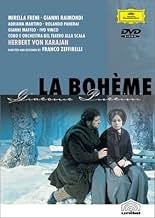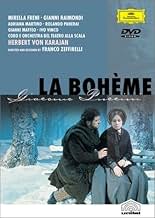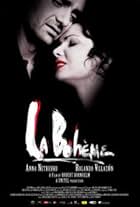Puccini's well-known opera.Puccini's well-known opera.Puccini's well-known opera.
- Awards
- 1 win
- Director
- Writers
- All cast & crew
- Production, box office & more at IMDbPro
Storyline
Did you know
- TriviaMirella Freni's debut.
- ConnectionsFeatured in Herbert von Karajan 1908-1989 (1999)
Featured review
Before writing these words, I pondered whether to comment on this film 1) as an opera, comparing it with other performances I've seen (and recordings I've heard), or 2) as a film, comparing it to other films I've seen. I am both an opera lover and a film lover.
To make this choice, I first asked myself if this film would appeal mainly to opera buffs, or to a more general (film-going) audience. La Boheme is one of the most `accessible' operas, a good `starter opera,' because of its recognizable music, and its appealing story and characters. If any opera on film might have crossover appeal, this is it.
I concluded that most (non-Italian) viewers not acquainted with opera, and La Boheme in particular, would not fully appreciate La Boheme the film. There are no subtitles, or summaries of the Acts or Scenes. A viewer would either need to know the story, or have a libretto (printed dialogue) to refer to, to understand what is going on.
Nevertheless, the beauty of the music may be enough for many viewers. The cast is uniformly excellent. Mirella Freni is a wonderful Mimi. I looked forward to her every aria and duet.
In looking at this as an opera among other operas, I appreciated some of the choices made by the film's makers. Most importantly, they did nothing to detract or distract from the music. The sets (designed by Franco Zeffirelli, who would later become a famous director; e.g., Romeo and Juliet) are mostly in muted earth tones with occasional splashes of red or yellow. The backdrops are clearly paintings, just like for a staged opera. The cast members use expressive gestures. The lighting is appropriate, and in some cases, an improvement over the limitations of stage lighting. Although the camera is usually set `in the audience,' it sometimes zooms in to highlight facial expressions.
The only shortcomings of any significance could be easily fixed in a re-release (celluloid and/or video). Subtitles should be available. I personally do NOT think they detract from the music, no matter how familiar the opera is. And the mono sound should be enhanced so long as it doesn't degrade the music in any way.
I reviewed this movie as part of a project at the Library of Congress. I've named the project FIFTY: 50 Notable Films Forgotten Within 50 Years. As best I can determine, this film, like the other forty-nine I've identified, has not been on video, telecast, or distributed in the U.S. since its original release. In my opinion, it is worthy of being made available again.
To make this choice, I first asked myself if this film would appeal mainly to opera buffs, or to a more general (film-going) audience. La Boheme is one of the most `accessible' operas, a good `starter opera,' because of its recognizable music, and its appealing story and characters. If any opera on film might have crossover appeal, this is it.
I concluded that most (non-Italian) viewers not acquainted with opera, and La Boheme in particular, would not fully appreciate La Boheme the film. There are no subtitles, or summaries of the Acts or Scenes. A viewer would either need to know the story, or have a libretto (printed dialogue) to refer to, to understand what is going on.
Nevertheless, the beauty of the music may be enough for many viewers. The cast is uniformly excellent. Mirella Freni is a wonderful Mimi. I looked forward to her every aria and duet.
In looking at this as an opera among other operas, I appreciated some of the choices made by the film's makers. Most importantly, they did nothing to detract or distract from the music. The sets (designed by Franco Zeffirelli, who would later become a famous director; e.g., Romeo and Juliet) are mostly in muted earth tones with occasional splashes of red or yellow. The backdrops are clearly paintings, just like for a staged opera. The cast members use expressive gestures. The lighting is appropriate, and in some cases, an improvement over the limitations of stage lighting. Although the camera is usually set `in the audience,' it sometimes zooms in to highlight facial expressions.
The only shortcomings of any significance could be easily fixed in a re-release (celluloid and/or video). Subtitles should be available. I personally do NOT think they detract from the music, no matter how familiar the opera is. And the mono sound should be enhanced so long as it doesn't degrade the music in any way.
I reviewed this movie as part of a project at the Library of Congress. I've named the project FIFTY: 50 Notable Films Forgotten Within 50 Years. As best I can determine, this film, like the other forty-nine I've identified, has not been on video, telecast, or distributed in the U.S. since its original release. In my opinion, it is worthy of being made available again.
Details
- Runtime1 hour 45 minutes
- Sound mix
- Aspect ratio
- 1.33 : 1
Contribute to this page
Suggest an edit or add missing content













